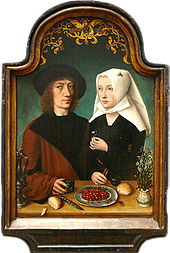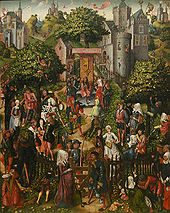- Master of Frankfurt
-
 Master of Frankfurt, Self portrait of the artist with his wife, 1496. Royal Museum of Fine Arts, Antwerp. This painting, in its original, dated, frame of 1496 shows a double portrait of the artist and his wife. The painter has included life-sized trompe l'oeil flies—seemingly on the painting's surface—an allusion to the classical artistic deceptions of Zeuxis and Parrhasius.
Master of Frankfurt, Self portrait of the artist with his wife, 1496. Royal Museum of Fine Arts, Antwerp. This painting, in its original, dated, frame of 1496 shows a double portrait of the artist and his wife. The painter has included life-sized trompe l'oeil flies—seemingly on the painting's surface—an allusion to the classical artistic deceptions of Zeuxis and Parrhasius.
The Master of Frankfurt (1460–c. 1533) was a Flemish Renaissance painter active in Antwerp between about 1480 and 1520.[1][2] Although he probably never visited Frankfurt am Main, his name derives from two paintings commissioned from patrons in that city, the Holy Kinship (c. 1503) in the Frankfurt Historical Museum and a Crucifixion in the Städel museum.[2] He is one of many anonymous artists identifiable by their painting style but not by name. The Master of Frankfurt is, however, often thought to be a Hendrik van Wueluwe, an artist famous in Antwerp around the same time as the anonymous painter but otherwise unconnected to any paintings.[1]
His dated Self portrait of the artist with his wife in its original frame (1496; Royal Museum of Fine Arts, Antwerp) reveals that the artist was 36 years old at the time it was made, as well as a member of Antwerp's Guild of St. Luke.[1] If he is the same artist as Van Wueluwe, then he was also dean of the guild six times. Attributed paintings include his self portrait, the Festival of the Archers (1493; Royal Museum of Fine Arts, Antwerp), and the two paintings in Frankfurt. The Master of Frankfurt is also known for painting numerous copies after earlier Netherlandish painters such as Rogier van der Weyden and Hugo van der Goes for the open market and for developing, around 1500 in Antwerp, a new artistic style alongside his more famous contemporary Quentin Metsys.[1]
References
- ^ a b c d Stephen H. Goddard, "Master of Frankfurt," Grove Art Online, Oxford University Press [accessed 9 April 2008]
- ^ a b Kate Challis, "Master of Frankfurt," The Oxford Companion to Western Art, ed. Hugh Brigstocke, Oxford University Press, 2001 (Grove Art Online, Oxford University Press, 2005). [accessed 9 April 2008]
Categories:- 1460 births
- 1530s deaths
- Renaissance painters
- Anonymous artists
- Members of the Antwerp Guild of Saint Luke
Wikimedia Foundation. 2010.

